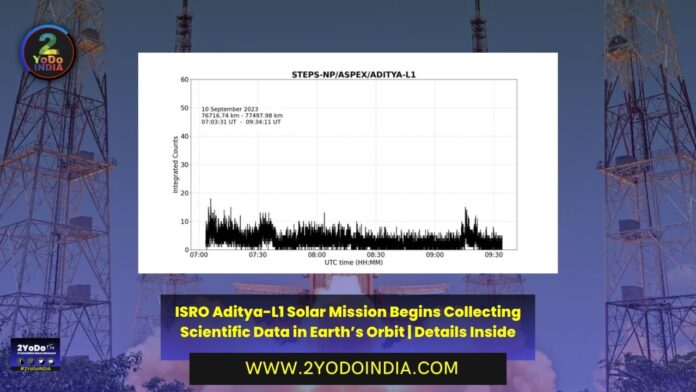Bharat’s Aditya-L1 solar mission spacecraft has start collecting scientific data to help scientists analyse particles surrounding Earth, ISRO said. The sensors on board India’s first solar observatory have begun measuring ions and electrons at distances greater than 50,000 km from Earth, ISRO announce in a post on X.
ISRO said that the sensors on STEPS or the Supra Thermal & Energetic Particle Spectrometer instrument began measuring supra-thermal and energetic ions and electrons at distances greater than 50,000 km from Earth.
The instrument is a part of the Aditya Solar Wind Particle EXperiment (ASPEX) payload of Aditya L1.
Aditya-L1 Mission:
— ISRO (@isro) September 18, 2023
Aditya-L1 has commenced collecting scientific data.
The sensors of the STEPS instrument have begun measuring supra-thermal and energetic ions and electrons at distances greater than 50,000 km from Earth.
This data helps scientists analyze the behaviour of… pic.twitter.com/kkLXFoy3Ri
STEPS has six sensors, each observing in different directions and measuring supra-thermal and energetic ions ranging from 20 keV/nucleon to 5 MeV/nucleon, in addition to electrons exceeding 1 MeV.
These measurements are conduct using low and high-energy particle spectrometers.
The data collect during Earth’s orbits helps scientists to analyse the behaviour of particles surrounding the Earth, especially in the presence of its magnetic field.
STEPS was activate on 10th September 2023 at a distance greater than 50,000 km from Earth.
This distance is equal to more than eight times the Earth’s radius, placing it well beyond Earth’s radiation belt region.
After completing the necessary instrument health checks, data collection continue until the spacecraft had move farther than 50,000 km from Earth.
These STEPS measurements will persist during the cruise phase of the Aditya-L1 mission as it progresses toward the Sun-Earth L1 point.
They will continue once the spacecraft is position in its intended orbit.
Data collect around Aditya-L1 would provide insights into the origin, acceleration, and anisotropy of solar wind and space weather phenomena.
STEPS was develop by the Physical Research Laboratory with support from the Space Application Centre in Ahmedabad.
Aditya-L1 was launch by ISRO on 2nd September 2023.
The Aditya-L1 carries 7 different payloads to study the Sun, four of which will observe the light from the Sun and the remaining three will measure in situ parameters of the plasma and magnetic fields.
Aditya-L1 will be place in a halo orbit around the Lagrangian Point 1 (L1), which is 1.5 million km from the Earth in the direction of the Sun.
Aditya-L1 will revolve around the Sun with the same relative position and hence can see the Sun continuously.





